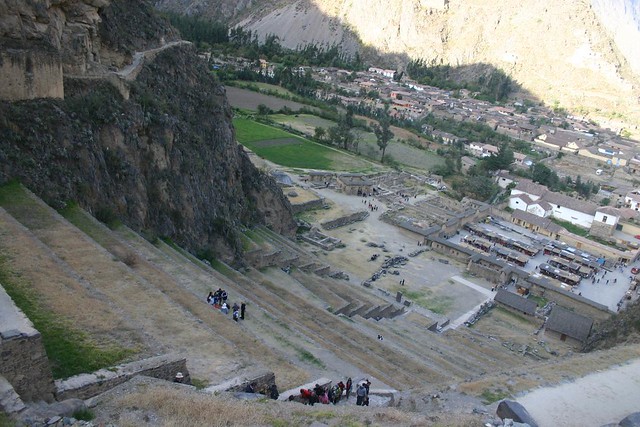On the sixth day it wasn’t such an early start – we were picked up by our tour guide at 8am for a journey through the Sacred Valley. The Sacred Valley is more commonly known to the indigenous people as the Urubamba Valley which was carved over time by the Vilcanota river. The valley runs from Pisaq (also spelt as Pisac) all the way to Ollantaytambo a town which was once the royal estate of Emperor Pachacuti. For this trip we had the American from the previous day with us, and a family of three Americans from Dallas, Texas. They were obviously Republicans who would have voted for Bush, so we decided to steer clear of any G.W. Bush related jokes.
To get to the Sacred Valley we had to drive high into the Andes past Sacsayhuaman and Tambo Machay before crossing a valley where were able to stop for pictures briefly – but then within an hour we were down in the Sacred Valley and driving alongside the Vilcanota river all the way to Pisaq. At the time we didn’t actually stop in Pisaq, we continued to drive back up into the mountains on the other side where there was an old Inca settlement called Puca Pucara which was built high up with many terraces below it. The view of the valley from up there was amazing even though we didn’t have time to look around the ruins we did get chance to take a few pictures there. The way sounds travelled through the mountains there was absolutely amazing – one of the locals was using a wind instrument and it could be heard all over the mountains there. Whilst in the Sacred valley we also visited a place where they kept various species of Llama and Alpaca and a gift shop full of Alpaca wool products.
Once we were satisfied we had enough pictures, we escaped the sun back into the confines of the tour bus and headed back to Pisaq where we stopped to look around our first proper Peruvian market. There was quite a variety of goods available such as tapestries, ornaments, jewelry, and much more; everything being hand crafted. After about 10 or 20 minutes looking round we were back on the tour bus and on our way to where we’d be stopping for dinner.
The restaurant was called Alhambra Restaurant and the food there was very nice. A lot of the food was the same as what we’d expect in England, though as with all Peruvian meals there were copious amounts of rice. One of the local cuisines that was actually very nice was a pie that contained pork, peppers, and banana – an unusual combination, but very nice. It was a very picturesque restaurant with a well maintained garden and a Macaw perched in one of the trees. It was a bit of a shy parrot, but I managed to coax an “Ola” out of it, but then didn’t manage to get him to repeat it in front of the others.
Our next stop was at a place called Ollantaytambo which is situated 2,792 metres above sea level. Before the Spaniards arrived there it served as a ceremonial city and a royal estate of Emperor Pachacuti. Once the Spanish arrived the city became a refuge for the Incas, and a place from which they could fight back. Today there is a modern town at the base of mountain and is a common tourist attraction, and a starting point for the Inca trail. I believe this town also featured in a cartoon series called “The Mysterious Cities of Gold” before they travelled to Machu Picchu – though neither place was referred to by name.
From the top of the stairs you can see huge stones which have been carved, some of which had not yet been put in place before the city fell. It is because of this that we have an insight into this great civilisation moved these enormous blocks. From atop the mountain you can see a good portion of the surrounding area, and also two carved faces in the side of other mountains; one of which is of Viracocha. The journey back from here was long, but was broken up by various stops to give us chance to take photographs of the sun setting behind glacial mountains.


